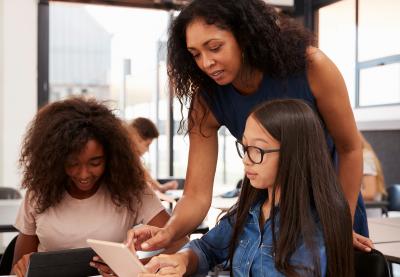Many schools will continue to operate with some distance learning options by offering hybrid or virtual learning as well as in-person learning. At the same time, in 2021, more anti-LGBTQ bills—specifically anti-trans bills—have been introduced and laws passed than in any other year on record. Hate speech and anti-LGBTQ conversations may end up in our classrooms, schools, homes and communities in this climate. That means educators must continue to openly prioritize creating and sustaining inclusive, affirming learning environments of all types for LGBTQ identities among students, staff and communities.
Before the switch to remote and hybrid learning last year, some schools worked to create affirming and inclusive environments for LGBTQ students with genders and sexualities alliances (GSAs), by displaying anti-bullying posters and pride flags, through advocating for gender-inclusive bathrooms and by including LGBTQ identities in the curriculum. In the switch to remote learning, many avenues for support changed or were lost altogether. As the fall approaches and various methods of learning take place, we must continue to be aware, supportive and inclusive of the unique needs of our LGBTQ students, and we must be aware of the messages we are sending to all students through our support or lack thereof.
Implement More Ways to Affirm
In the 2019 GLSEN School Climate Survey, only 19.4% of surveyed LGBTQ students reported learning affirming content about LGBTQ people in school. GLSEN also reports lower grade point averages when compared to their non-LGBTQ peers. Many reports, including this 2020 report by the Trevor Project, show that LGBTQ students have higher levels of stress, depression and substance use, all of which have been exacerbated by increased social isolation and conditions of the pandemic. The recent rise of anti-LGBTQ legislation will only add to this stress. All of this is concerning; however, these reports also show affirming environments and strong social support networks can make a significant difference in the lives of LGBTQ youth.
As we create school policies and discuss classroom values for in-person, remote or hybrid learning, we must keep current legislative activity in mind. And we must be consistently clear that the classroom is a space that is welcoming of all people, a space in which hate speech is not tolerated. We must demonstrate those values by practicing it ourselves, by including the wide range of diversity of LGBTQ people in our curriculum, and by objecting to hate speech in our classrooms and from school staff.
If and when a student or caregiver pushes back or argues in line with current regressive thinking against the inclusion of LGBTQ identities, it’s critical that educators reiterate our values: All people, including LGBTQ people, are welcome here, and we teach content that is reflective of the world we want to see and the world our students deserve to live in—a world where LGBTQ people are valued and included.
If a student is learning in any space that is not affirming of LGBTQ people, the classroom values and expectations will still teach respect and support the student if they are able to participate in the conversation. This is more important than ever as the battle over what can be taught in schools wages on. As K-12 educators face more scrutiny about what they share with their students and how, we need to ensure diversity in the curriculum with LGBTQ inclusive content that shows such diversity in gender, sexuality, race, culture, disabilities, class, religion, language and any and all combinations of these identities.
The inclusion of LGBTQ identities in our curriculum and classroom content can be done at all grade levels and at all times. This does not mean that every lesson needs to be an elaborate exploration of queer history or theory. Instead, it means using gender-inclusive language. It means reading books with LGBTQ characters that display the diversity of experiences in the LGBTQ community. It means that when we talk about our hopes and dreams, we are also dreaming of a reality that is in inclusive and affirming of all LGBTQ identities.
Lessons of Acceptance and Inclusion
A classroom inclusive of LGBTQ people is a classroom that teaches implicit and explicit, micro and macro, historical and present-day lessons of respect and inclusion. It is a classroom that consistently models inclusion and affirmation through language, expectations and actions.
Educators must keep the conversation going at this critical juncture. Above all, we cannot rely on or expect our students to bring in conversations about LGBTQ people. It is our job as educators, no matter what, to share content that positively represents the diversity of people that we share this world with and the diversity of people that are in our classrooms. It is our job to create learning opportunities that affirm students and prepare them to interact with all people in society. It is our job to share content that teaches students to think critically and openly and gives them the language they need to stand up for each other and have these conversations on their own.
Regardless of how learning takes place in the fall and as the controversy over curriculum content continues, we must create varied and consistent opportunities to support and affirm the identities of our LGBTQ students. And it’s vital that we share accurate representations of LGBTQ people in our schools.
